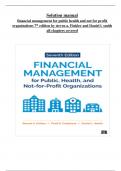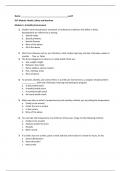Solution manual
financial management for public health and not for profit
organizations 7th edition by steven a. Finkler and Daniel l. smith
all chapters covered
,Chapter 1 n
Questions for Discussion
n n
1-
1.n Financialnmanagementn isn then subsetn ofnmanagementn thatn focusesnonngeneratingnfinancialninformatio
nn thatn cann improven decisions.n Then decisionsn aren orientedn towardn achievingn then variousn goalsn ofn th
en organizationnwhilen maintainingnan satisfactorynfinancialnsituation.nFinancialnmanagementn encompasse
sn thenbroadnareasnofnaccountingnandnfinance.
1-2.n Inn proprietary,n orn for-
profit,n organizations,n ann underlyingn goaln isn ton maximizen then wealthn ofn then ownersnofnthenorganizati
on.
1-
3.n Inn publicn servicen organizations,n decisionsn aren orientedn towardn achievingn then variousn goalsn ofn th
en organizationnwhilenmaintainingnansatisfactorynfinancialnsituation.
1-
4.n Accountingn isn an systemnforn keepingn trackn ofnthen financialnstatusn ofnannorganizationn andn then financia
ln resultsn ofn itsn activities.n Itn hasn oftenn beenn referredn ton asn then languagen ofn business.n Then vocabulary
n usednbynaccountingnisnthenlanguagenofnnonbusinessnorganizationsnasnwell.
1-
5.n Accountingn isn subdividedn inton twon majorn areas:n managerialn accountingn andn financialn accountin
g.n Managerialn accountingn relatesn ton generatingn anyn financialn informationn thatn managersn cann usen t
on improven then futuren resultsn ofn then organization.n Thisn includesn techniquesn designedn ton generaten an
yn financialndatan thatn mightn helpn managersnmaken moren effectiven decisions.n Majorn aspectsnofnmanageria
ln accountingn relatenton makingn financialnplansnforn then organization,n implementingn thosen plans,n andn then
n workingn ton ensuren thatn then plansn aren achieved.n Somen examplesn ofn managerialn accountingn include
n preparingn annualn operatingn budgets,n generatingn informationn forn usen inn makingn majorn investment
n decisions,n andn providingn then datan neededn ton deciden whethern ton buyn orn leasenan majorn piecen ofn
equipment.n Financialn accountingn providesn retrospectiven information.n Asn eventsn thatn haven financialn i
mplicationsnoccurntheynarenrecordednbynthen financialnaccountingnsystem.n Fromntimenton timen(usuallyn m
onthly,n quarterly,n ornannually),n thenrecordedn datanarensummarizednandnreportedntoninterestednusers.n Th
en usersn includen bothn internaln managersn andn peoplen outsiden then organization.n Thosen outsidersn incl
uden thosen whon haven lentn orn mightn lendn moneyn ton then organizationn (creditors),n thosen whon mightn selln t
hingsn ton then organizationn (calledn suppliersn orn vendors),n andn othern interestedn parties.n Thesen intere
stednpartiesnmaynincludenthosenwithnanparticularninterestn innpublicnservicenorganizations,nsuchnasn regula
tors,n legislators,n andn citizens.n Financialn reportsn providen informationn onn then financialn statusn ofn then org
anizationnatn anspecificnpointn inntime,n asnwellnasnreportingnthenpastn resultsnofnthenorganization‘sn operatio
nsn(i.e.,nhownwellnitnhasndonenfromnanfinancialnviewpoint).
,
, Chaptern3:nAdditionalnBudgetingnConcepts 3-2
1-
6.n Financenfocusesnonn thenalternativensourcesnandnusesnofn thenorganization‘sn financialn resources.n O
btainingn fundsn whenn neededn fromnappropriaten sourcesnandn then deploymentn ofnresourcesnwithinnthen or
ganizationn falln undern thisn heading.n Inn addition,n financen involvesn then financialn marketsn (suchn asn st
ocknandnbondnmarkets)nthatnprovidenanmeansnton generatingnfundsnfornorganizations.
1-
7.n Yes.n Achievingn then goalsn ofn then organizationn requiresn financialn planning.n Financialn manageme
ntn providesn informationn forn managersn ton usen inn makingn theirn decisions.n Itn helpsn managersn byn provi
dingn informationn onn then likelyn financialn impactn ofn eachn proposedn alternative.n Itn alson providesn infor
mationnaboutn financialnstability,nefficiency,nandneffectiveness.
1-
8.n Clearly,n wen mightn expectn somen publicn servicen organizationsn thatn aren proprietary,nsuchn asn som
en hospitals,n ton earnn profits.n Butn whatn aboutn othern publicnservicen organizationsn suchnasncharities?nThe
yn shouldn maken an profitn asn well.n Profitsn providen an safetyn marginn againstn unexpectedn costs,n provid
en resourcesnton replacenbuildingsnandnequipment,n andnton expandnandnimprovenservices.
1-9.nn Federalngovernmentn(seentextnFiguren1-1)
◼ Individualnincomentaxes
◼ Socialninsurancentaxes
◼ Corporatenincomentax
Statenandnlocalngovernmentn(seentextnFiguren1-4)
◼ Salesnandngrossnreceiptsntax
◼ Federalngovernment
◼ Propertyntaxes
◼ Individualnincomentaxes
Healthnsectorn(seentextnFiguren1-6)
◼ Privateninsurance
◼ Medicare
◼ Medicaid
◼ Otherngovernmentnprograms
Not-for-profitnsectorn(seentext)
◼ Privatenpaymentsnforngoodsnandnservices
◼ Governmentnpaymentsnforngoodsnandnservices
◼ Donations
1-
10.nFederalngovernmentn spendingn exceededn $6n trillionninn2020n andn staten andnlocalngovernmentn spendi
ngn wasn moren thann $3n trillionn inn 2018.n Inn contrast,n then GDPn wasn $21n trillionninn 2020.n Forn moren upn to
n daten information,n examinen then statisticaln tablesn ofn then mostn recentn Economicn Reportn ofn then Preside
nt,nwhichnisnavailablenonline.
1-
11.nThen reportedn surplusn includesn bothn onn andn offn budgetn items.n Socialnsecurityn taxesn representn annof





